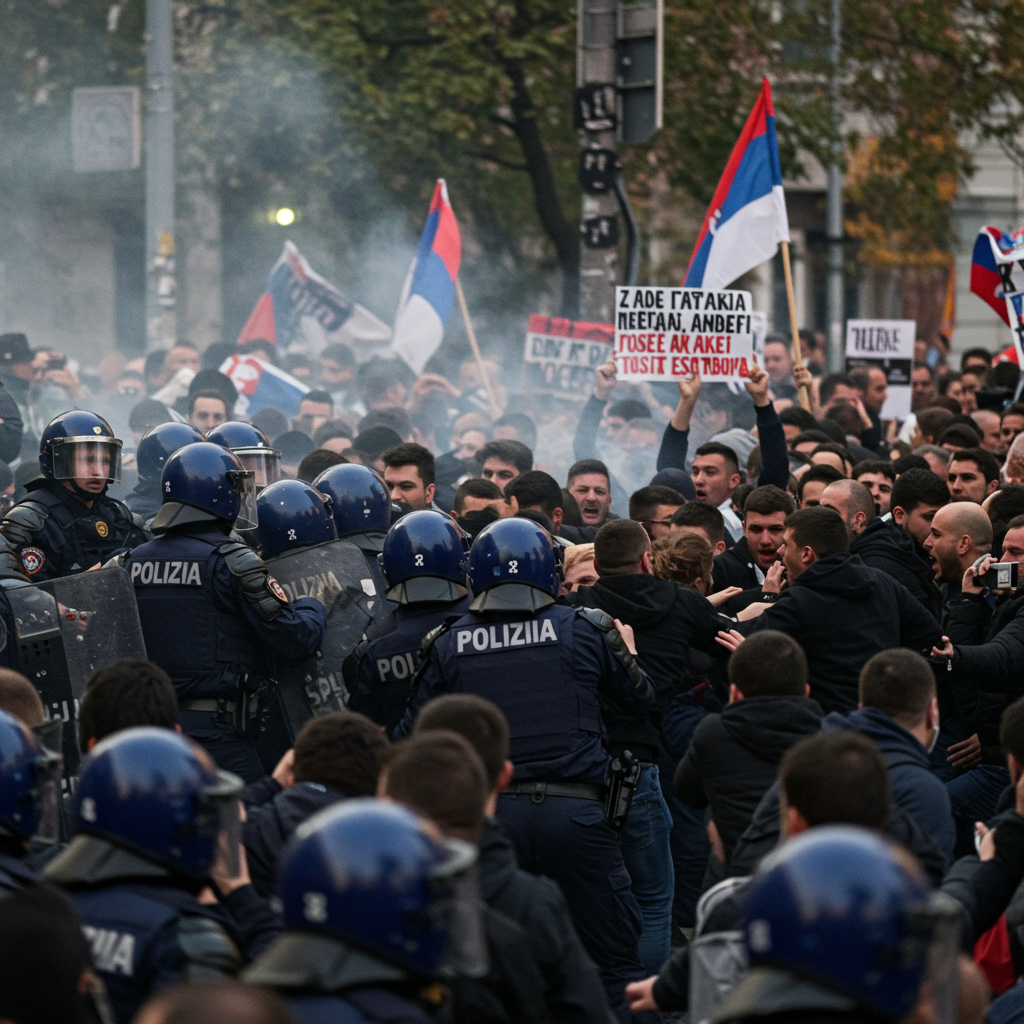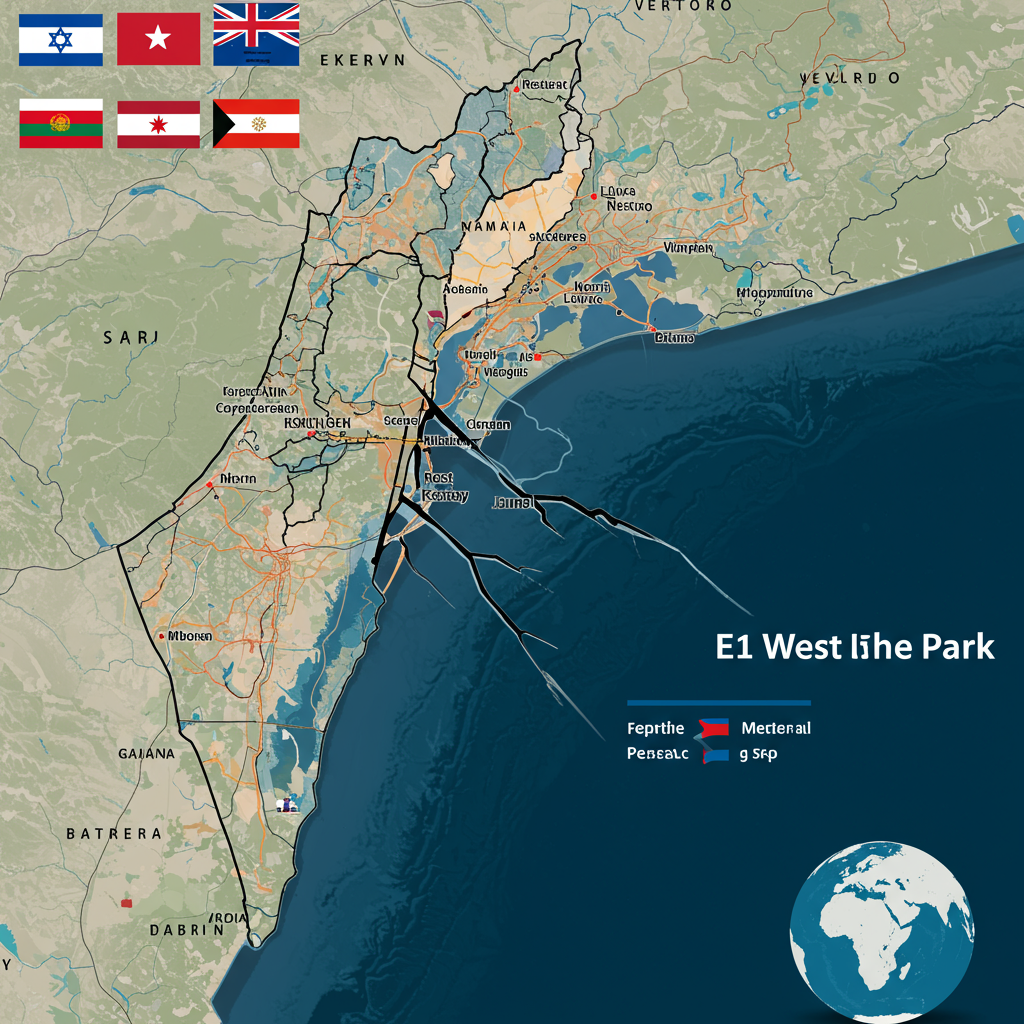Police and anti-government protesters clashed violently in Belgrade on Saturday, June 28, 2025, during a major demonstration demanding early parliamentary elections. Thousands gathered in the Serbian capital, escalating months of persistent dissent against the rule of populist president Aleksandar Vucic. The confrontation unfolded after the formal rally concluded, highlighting the deep tensions gripping the Balkan nation.
This latest event is part of a movement that began after a tragic infrastructure collapse. Demonstrators blame widespread government corruption for the disaster and subsequent issues. The push for a snap election has become the central focus for a diverse group of citizens, notably led by university students. Despite government pressure and crackdowns, the protests continue, signaling enduring public dissatisfaction and rattling the president’s decade-long hold on power.
Belgrade Erupts: The Saturday Confrontation
Belgrade’s central Slavija Square became the focal point of a massive demonstration on Saturday. Estimates of the crowd size varied significantly; Serbian police reported 36,000 participants at the outset. However, independent monitoring groups, such as the Independent Protest Monitor, Archive of Public Gatherings, put the figure much higher, estimating around 140,000 attendees. This potentially marked one of the largest turnouts in recent months, with many people unable to reach the main square due to the sheer numbers.
The atmosphere was charged with tension from the start. Riot police units were heavily deployed near government buildings and close to a camp of Vucic’s loyalists. Protesters filled the air with chants of “We want elections!” As the official rally neared its end, organizers urged the crowd to assert their freedom, a call that preceded the ensuing clashes.
Violent Skirmishes Break Out
Following the planned conclusion of the demonstration, confrontations erupted. Groups of protesters and riot police engaged in skirmishes near the loyalist camp and police lines. Authorities deployed tear gas, pepper spray, and stun grenades to disperse crowds. Protesters responded by throwing flares, eggs, plastic bottles, and other projectiles towards the police.
The clashes resulted in injuries on both sides. Police Director Dragan Vasiljevic confirmed that six police officers were injured. Reports also indicated injuries among demonstrators. Dozens of protesters were detained during the unrest. Some were seen being handcuffed by officers. The intensity of the confrontation highlighted the volatile nature of the ongoing political crisis.
The Deep Roots of Discontent
The current wave of anti-government protests in Serbia traces back to a specific tragedy in late 2024. On November 1, 2024, a newly renovated railway station canopy in Novi Sad collapsed, killing 16 people. Many Serbians viewed this disaster not as an isolated incident but as a direct consequence of rampant government corruption and negligence in overseeing critical state infrastructure projects.
This event became a powerful catalyst. It fueled pre-existing frustrations over perceived corruption, lack of accountability, and erosion of democratic freedoms under President Vucic and his ruling Serbian Progressive Party (SNS). The widespread anger triggered sustained demonstrations across the country, initially focusing on corruption but quickly evolving into a broader anti-government movement. The pressure stemming from this crisis did lead to the resignation of the previous Prime Minister, Milos Vucevic, earlier in the year, but President Vucic himself has remained firmly in power.
The Central Demand: Early Elections
At the heart of the sustained protest movement lies a clear demand: the immediate calling of early parliamentary elections. Protesters and opposition figures argue that elections are the only legitimate way to resolve the current social and political crisis. They view the current government as illegitimate, as articulated by a student speaker on Saturday who declared, “Today, on June 28, 2025, we declare the current authorities illegitimate.”
University students have played a particularly prominent role in leading and organizing the protests. Their resolve remains strong, with students expressing determination to continue demonstrating “as long as it takes until the demands are met,” according to law student Stefan Ivakovic. Many protesters voiced a belief that state institutions have been “usurped” and that elections are the necessary path forward, although some remain skeptical that President Vucic would cede power peacefully. Organizers had issued an “ultimatum” to President Vucic to announce elections by a deadline, a demand he firmly rejected.
President Vucic’s Defiant Stance
President Aleksandar Vucic and his right-wing SNS party have consistently refused the protesters’ calls for early elections. The next scheduled presidential and parliamentary elections are not due until 2027. Vucic has publicly dismissed the demonstrations, often portraying them as politically motivated attempts to destabilize Serbia.
He has repeatedly accused protesters of being part of a “foreign plot” aimed at “toppling Serbia,” though he has not specified which foreign powers he believes are involved. On Saturday, Vucic reiterated this stance, stating, “The country will be defended, and thugs will face justice.”
Government Response and Crackdown
In the days leading up to the major Saturday rally, authorities intensified efforts seen by critics as a crackdown intended to suppress dissent and reduce turnout. Police arrested numerous anti-government activists on serious charges, including allegedly plotting to overthrow the government or terrorism, allegations denied by those arrested. Officials also banned entry to several foreign nationals from neighboring countries without explanation.
The state railway company halted train services citing an alleged bomb threat, a move critics interpreted as an attempt to prevent people from traveling to Belgrade for the rally. These actions mirrored measures reportedly taken before previous large-scale protests in March. Furthermore, hours before the student-led rally, Vucic’s party bused in scores of loyalist supporters from other parts of the country to Belgrade. These supporters joined a pro-government encampment that has been maintained in central Belgrade’s Pionirski Park since mid-March.
Broader Political Landscape
President Vucic, a former extreme nationalist, has faced increasing accusations of becoming more authoritarian since coming to power over a decade ago. Critics argue that while he formally expresses a desire for Serbia to join the European Union, his government has simultaneously stifled democratic freedoms, increased pressure on independent media, and strengthened ties with countries like Russia and China. Serbia remains an EU candidate country but has not joined Western sanctions against Moscow following the invasion of Ukraine.
The protests occur within a complex political context. Accusations against Vucic and his allies include alleged ties to organized crime, violence against political opponents, and curbing media freedoms – charges the government denies. Recent local elections saw narrow victories for the ruling party amidst accusations of voter bribery and interference, echoing similar claims made after the December 2023 parliamentary elections, which Vucic also denied. Despite government efforts to maintain control and discredit the movement, the large turnout on St. Vitus Day – a date holding symbolic historical importance for Serbs – underscores the depth of persistent anger and the ongoing challenge to Vucic’s long-standing authority.
Persistence Despite Pressure
The anti-government movement has now persisted for nearly eight months. Despite government pressure, arrests, accusations of foreign interference, and attempts to hinder participation, the large turnout on Saturday demonstrated that the resolve among protesters remains strong. The clashes marked a significant escalation in the confrontation between the state and its citizens demanding fundamental change.
While the government continues to reject demands for early elections and dismiss the legitimacy of the protests, the movement, particularly led by dedicated university students, shows no signs of abating. The events of June 28, 2025, in Belgrade underscored the deep division within Serbian society and the ongoing struggle for accountability and democratic reform.
Frequently Asked Questions
What sparked the recent wave of anti-government protests in Serbia?
The immediate trigger for the most intense wave of protests was the collapse of a newly renovated railway station canopy in Novi Sad on November 1, 2024, which killed 16 people. Many Serbians attributed this tragedy to pervasive government corruption and negligence in state infrastructure management under the current administration, fueling widespread public anger and demands for accountability that evolved into broader anti-government sentiment.
Who is leading the anti-government protest movement in Serbia?
The recent anti-government protests are notably student-led. University students across Serbia have been a key organizing force behind the demonstrations, calling for early elections and reforms. The movement also includes participation from opposition figures, teachers, workers, farmers, and other citizens frustrated with the government and President Aleksandar Vucic’s rule.
Why are protesters demanding early elections in Serbia?
Protesters are demanding early parliamentary elections as they view them as the only legitimate way to resolve the ongoing political and social crisis in Serbia. They accuse the current government, led by President Vucic and the SNS party, of widespread corruption, undermining democratic institutions, curbing media freedoms, and mismanaging the country. They believe a snap election is necessary to usher in a new government that truly represents the interests of the people and addresses these deep-seated issues.
Conclusion
The clashes in Belgrade on June 28, 2025, vividly illustrated the growing confrontation between Serbian authorities and a persistent anti-government movement demanding early elections. Fueled by anger over corruption and catalyzed by a tragic infrastructure failure, the protests, significantly driven by university students, have become a major challenge to President Aleksandar Vucic’s rule. Despite government efforts to suppress the demonstrations through crackdowns, arrests, and counter-mobilization, the large turnout and intense confrontations underscore the depth of public dissatisfaction and the unwavering demand for accountability and political change in Serbia. The standoff over snap elections continues, leaving the country’s political future uncertain.




